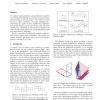Free Online Productivity Tools
i2Speak
i2Symbol
i2OCR
iTex2Img
iWeb2Print
iWeb2Shot
i2Type
iPdf2Split
iPdf2Merge
i2Bopomofo
i2Arabic
i2Style
i2Image
i2PDF
iLatex2Rtf
Sci2ools
CCCG
2010
2010
Zipper unfoldings of polyhedral complexes
We explore which polyhedra and polyhedral complexes can be formed by folding up a planar polygonal region and fastening it with one zipper. We call the reverse process a zipper unfolding. A zipper unfolding of a polyhedron is a path cut that unfolds the polyhedron to a planar polygon; in the case of edge cuts, these are Hamiltonian unfoldings as introduced by Shephard in 1975. We show that all Platonic and Archimedean solids have Hamiltonian unfoldings. We give examples of polyhedral complexes that are, and are not, zipper [edge] unfoldable. The positive examples include a polyhedral torus, and two tetrahedra joined at an edge or at a face.
| Added | 29 Oct 2010 |
| Updated | 29 Oct 2010 |
| Type | Conference |
| Year | 2010 |
| Where | CCCG |
| Authors | Anna Lubiw, Erik D. Demaine, Martin L. Demaine, Arlo Shallit, Jonah Shallit |
Comments (0)

